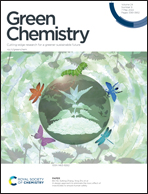Transformation of phytosterols into pregnatetraenedione by a combined microbial and chemical process†
Abstract
Pregna-1,4,9(11),16(17)-tetraene-3,20-dione (pregnatetraenedione) is the most useful precursor for the synthesis of corticosteroids in industry. However, the production of pregnatetraenedione is still a complex and expensive process. Here, we proposed a greener and more economical route for the synthesis of pregnatetraenedione, which was achieved via the conversion of phytosterols to an uncommon steroid compound, 9α-hydroxy-3-oxo-4,17(20)-pregna-diene-20-carboxylic acid (9-OHPDC), by an engineered Mycolicibacterium neoaurum. 9-OHPDC is a metabolite of sterols obtained by partially degrading its C17 side-chain and hitherto it is difficult to exclusively produce due to its complex metabolic process. In this study, we systematically investigated the determinants related to the generation of 9-OHPDC in the metabolic process of phytosterols and developed a 9-OHPDC-producing strain with the methyl-esterified 9-OHPDC (9-OHPDC-M) as the main product by metabolic engineering. The production of 9-OHPDC and 9-OHPDC-M respectively reached 9.86 g L−1 and 1.27 g L−1 in about 6 days and the total mole yield was more than 85.9%. Using 9-OHPDC-M as a synthon, subsequently, a four-step chemical process for the synthesis of pregnatetraenedione was designed and verified, which was composed of the following steps: hydrolysis of 9-OHPDC-M to 9-OHPDC, decarboxylation rearrangement, dehydration and Δ1 dehydrogenation. From phytosterols to pregnatetraenedione, the combined microbial and chemical process showed a total weight yield of up to 35.4%, significantly higher than that of the current industrial routes. In addition, compared with the current routes, the new synthesis route has the advantages of shorter reaction steps, milder reaction conditions, reduced use of organic solvents and abandonment of toxic catalysts. In a word, this study provided a green route for the production of pregnatetraenedione, which can be used for corticosteroid production in industry.



 Please wait while we load your content...
Please wait while we load your content...